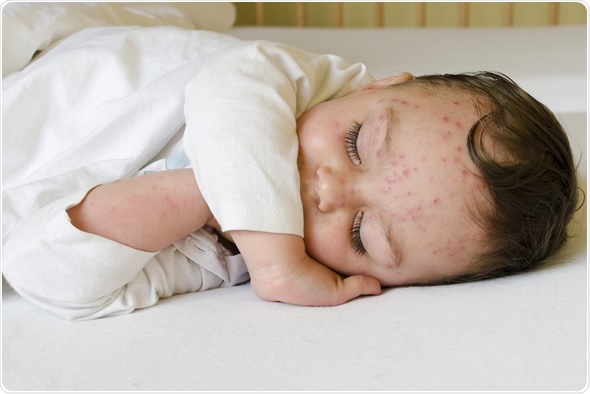There are many viral and bacterial infections that commonly affect young children. Each of these is characterized by particular symptoms that distinguish them and the recommendations for their management. Several of the most prominent childhood infections are covered in more detail below.
Chicken Pox
Chickenpox is a viral infection that is characterized by a rash that begins as raised pink spots that eventually blister and scab. The rash can be very itchy and the infection may be accompanied by other symptoms such as a runny nose and fever.
Children with chickenpox should be kept at home for 5 days from the first sign of the rash until the blisters have crusted over. Chickenpox can also be prevented with a vaccination.

Sleeping child with red spots on his skin of chicken pox. Image Copyright: pavla / Shutterstock
Conjunctivitis
Conjunctivitis is an infection of the conjunctiva in the eyes that commonly affects children. It often causes the eyes to become red and feel scratchy. The eyelids may also stick together, particularly when the child wakes up in the morning.
Children with conjunctivitis should be kept at home as long as there is any discharge from the eyes, as this can pass the infection on to other children. It is also recommended to wash hands regularly and avoid sharing personal hygiene products, such as towels.
Gastroenteritis
Gastroenteritis is a common infection of the gastrointestinal tract, which may lead to symptoms such as nausea, vomiting, diarrhea, fever and headache.
To prevent the spread of infection to other children, children should stay at home for at least 24 hours after the last bout of vomiting or diarrhea and be careful to wash hands well after using the toilet and handling food.
Rubella
Also known as German Measles, rubella is a relatively mild infection in most cases that causes symptoms similar to a common cold in children such as a runny nose and mild fever, in addition to a temporary pink rash on the skin.
However, it has the potential to cause birth defects if a pregnant woman is affected and, therefore, expectant mothers with young children should be wary of the infection. Immunization is recommended for all young children and women planning to conceive.
Hand Foot and Mouth Disease
Hand food and mouth disease is usually a mild illness that is associated with blisters around the mouth or on the hands and feet. It may also be accompanied by other symptoms, such as fever.
To avoid passing the infection on to other children, affected children should stay at home until the blisters have dried and wash hands carefully after touching affected areas and using the toilet.
School Sores
Also know as impetigo, school sores is an infection that commonly affects school-aged children. It is characterized by the appearance of small, red spots on the face, hands and scalp that become pus-filled blisters that eventually crust over.
To prevent the spread of infection, affected children should stay at home until treatment with antibiotics begins and the sores are covered with the appropriate dressing.
Influenza
Influenza is a common infection in both children and adults. Symptoms may include a runny nose, sore throat, cough, fever, muscle aches and headache.
Affected children should stay at home until they feel better. Washing hands carefully can help to prevent the spread of infection to others.
Measles
The measles is characterized by a red blotchy rash on the face and body and associated with other symptoms such as fatigue, runny nose, cough and fever.
Children with the measles should be kept at home for at least 4 days after the initial appearance of the rash. Immunization is also available to prevent the infection.
Meningococcal Disease
Meningococcal disease involves a sudden fever and other symptoms such as headache, fatigue, skin rash, neck stiffness, nausea and vomiting.
If a child develops these symptoms suddenly, they should receive immediate medical attention, as timely antibiotic treatment is required. Immunization is also available to prevent the infection.
Mumps
Symptoms characteristic of mumps include swollen or tender glands around the jaw and fever.
Children affected by mumps should be kept home for 9 days after the swelling begins to prevent spread of the infection to others. Immunization is also available for children.
Scarlet Fever
Scarlet fever is marked by sudden onset of symptoms including a sore throat, fever and vomiting. A rash follows 1-2 days later.
Affected children should be kept at home for at least 24 hours after the initiation of treatment when they feel better.
Whooping Cough
Whooping cough usually begins with symptoms similar to a common cold with a runny nose, but the persistent cough with the characteristic whooping sound as the child gasps for air is a marking symptom. Some children may also experience vomiting.
Affected children should stay at home until 5 days after the initial dose of the antibiotic treatment for the infection. Immunization is also recommended to prevent the infection in young children.
References
Further Reading
Last Updated: Dec 30, 2022